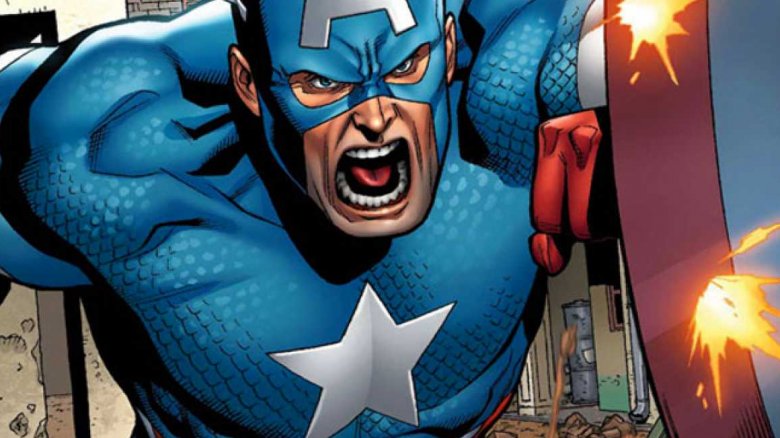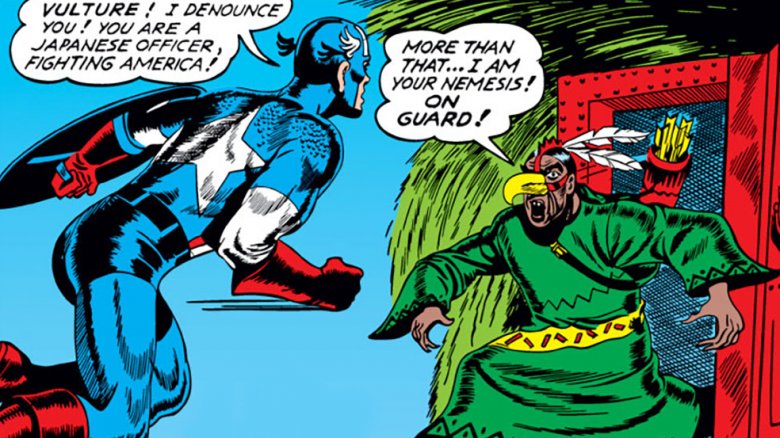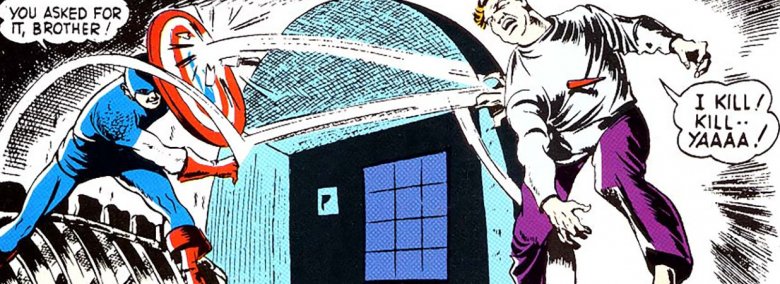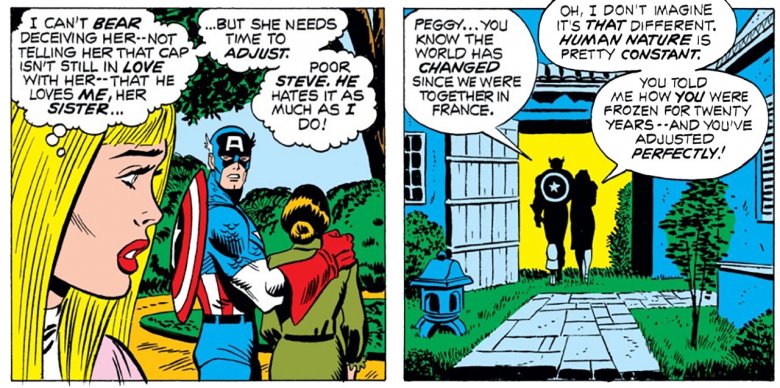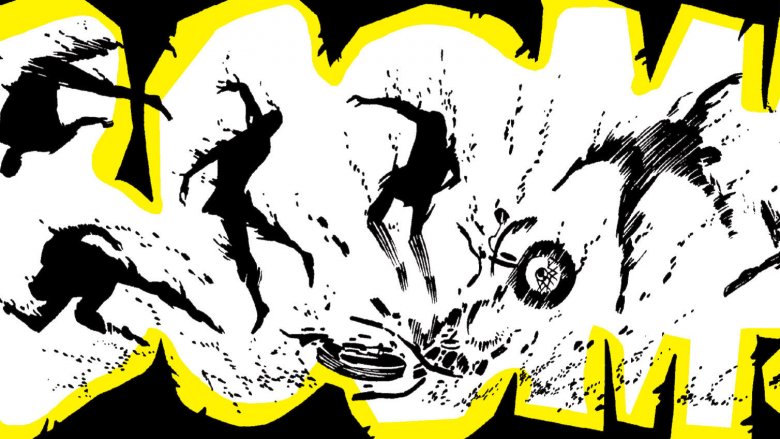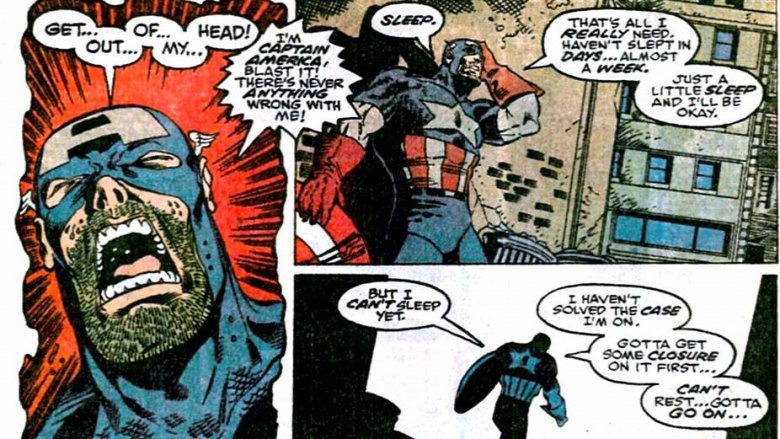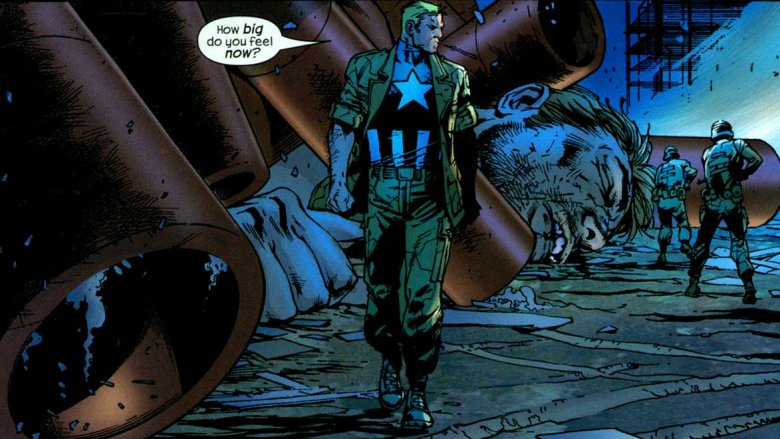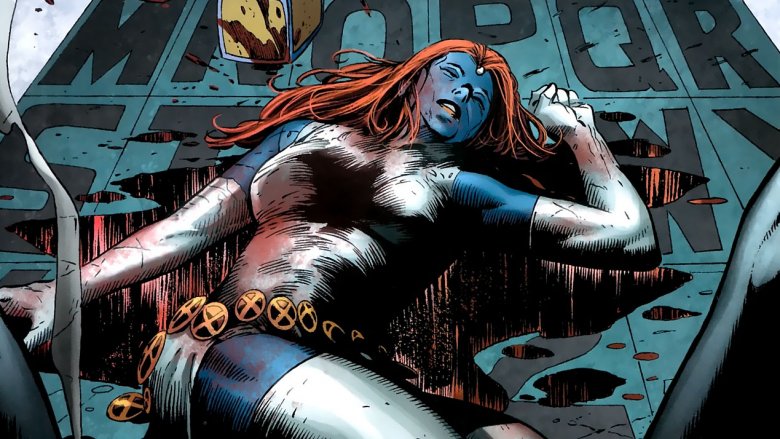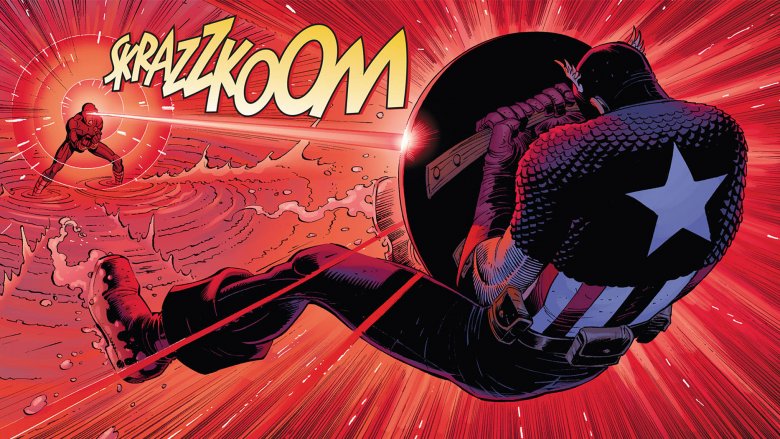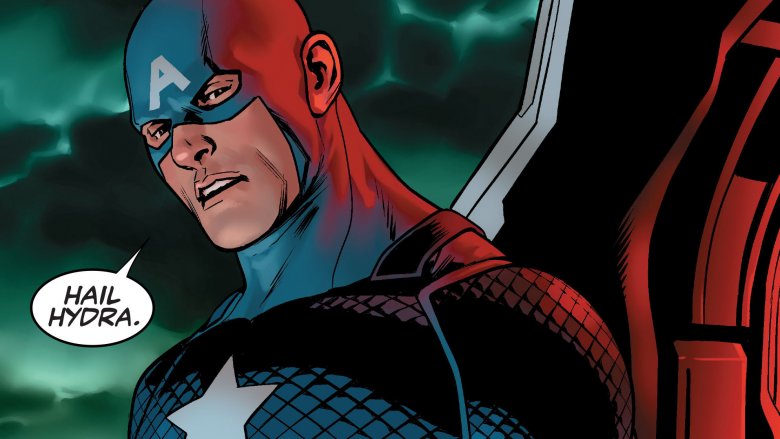The Most Terrible Things Captain America Has Ever Done
The Super-Soldier Serum might've given Steve Rogers enhanced strength, reflexes, and endurance, but it didn't give him courage, or determination, or heart. It isn't super powers that make Captain America a hero. Underneath that cowl, he's a fundamentally good person.
Or is he? Captain America is still just a man, and men make mistakes. All of them. Whether it's falling victim to the prejudices in the world around him, royally screwing up with women, going a little too far in combat, or hiding his affiliation with a Nazi subgroup for decades in a plot to take over the world (wait, what?), sometimes, despite his best efforts, Steve Rogers does something less-than-super. But can we really blame him? After all, nobody's perfect.
Casually racist
Captain America was born from World War II—not only was the Super-Soldier Serum devised in order to give the Allies an edge over the Nazis, but creators Joe Simon and Jack Kirby introduced Cap to the world by having him sock Hitler in the face—and some of his earliest adventures reflect the attitudes of that era.
Unfortunately, that includes a fair share of racism. In some cases (like, say, when Steve Rogers is facing off against Axis-sympathizing Japanese foes), while it's not okay, it's understandable. Other infractions aren't quite as easy to explain. In Captain America Comics #6, Captain America cracks, "Here come some China boys, and they're not waving laundry tickets!" That's suspect at best, and a little later, it gets even worse.
In Captain America Comics #14, a group of Native Americans blow up a truck containing Steve Rogers and his sidekick, Bucky. In response, Steve changes into his Captain America uniform and rallies Bucky into action by exclaiming, "C'mon let's give their copper colored hides some exercise!" Now, remember, this comic came out in 1942. Native Americans had been official American citizens for 18 years. And yet, Cap doesn't seem to have any problem dropping a few slurs against the members of the country he claims to represent as long as he thinks they're in the wrong.
Don't worry, though. As it turns out, the Native American attacker is actually a white guy disguised as a Japanese spy disguised as a Native American, so that makes it all okay, right? Right?
Yeah, we didn't think so either.
Death by dinosaur
Captain America is a soldier, and sometimes, in the heat of battle, soldiers have to kill. For better or worse, that's how war works. It happens. However, there's a big difference between taking another man's life on the battlefield and murdering a petty thug on domestic soil, even if that thug is built like a small gorilla and locked your sidekick inside a mummy's sarcophagus, where he's slowly suffocating to death.
It's not just that Captain America kills Lenny, henchman for the villainous Butterfly, either. It's how he kills him. In Captain America Comics #3, Steve Rogers is staking out the local museum, where the Butterfly has been appearing night after night to steal priceless artifacts. When Bucky fails to meet Steve at their agreed-upon time, Rogers rushes to the museum and hides out until it closes, then slips into his costume and starts investigating. Lenny, who's posing as the museum curator's assistant, draws a knife, but before he can attack, Captain America snaps a horn off of a dinosaur skeleton that happens to be nearby and hurls it through Lenny's heart.
The Butterfly—who is actually the curator himself, of course—doesn't get off any easier. As the Butterfly shoots at Cap from above, the Star-Spangled Avenger hurls his shield at his hovering foe, knocking him to the ground and snapping his neck. And before you get any ideas, don't think that Captain America feels bad about the double homicide for even a second: outside the museum, a passerby claims that it's "a great day for justice," and Rogers and Bucky head back to the army camp, laughing the whole way.
Two at a time
Captain America has a type: ladies with the last name Carter. During World War II, Steve Rogers spends much of his time flirting with Peggy Carter, a member of the French Resistance in the comics and one of the highest-ranking officers in the Strategic Scientific Reserve in the comics. When Captain America wakes up in the modern age, he starts macking on Peggy's grand-niece, Sharon.
It's weird enough that Captain America's ex is his current girlfriend's great aunt (Hayley Atwell, who plays Peggy in the Marvel Cinematic Universe, thinks it's pretty gross), but it could be worse. In fact, at one point, it was. When Marvel first revived Captain America in the '60s, World War II wasn't that long ago, and Sharon was originally introduced as Peggy's younger, more attractive sister. Steve Rogers and Sharon still fell in love, but Peggy was very much still in the picture—in fact, thanks to a case of amnesia, she wasn't aware that Steve's feelings had changed over time. Sharon decides not to tell her, either, in order to protect her feelings.
Eventually, Peggy moves on (and then the whole escapade is retconned out of continuity as Marvel's sliding timeline transforms Sharon into a great-niece rather than a sister). Still, for a while there, Captain America was either leading Peggy on or flat-out cheating on Peggy with her younger sister, depending on your perspective. Either way, that's pretty low, especially for someone as principled as Cap.
Death by flaming bike
You know who sets up elaborate death traps in order to kill their enemies? Supervillains. You know who shouldn't? Captain freakin' America. It's one thing to kill in self-defense or as a last resort. It's another to fill your motorcycle with a special "exclusive fuel" before arriving at a battle, herd all of your foes into a contained, and then detonate your bike, burning a small army alive.
That takes planning and calculation, and it's exactly what Cap does in Captain America #113, written and drawn by Jim Steranko. In the book, Captain America launches an elaborate scheme that begins with him faking his own death, culminates in the motorcycle-assisted killing of a dozen Hydra agents (and the death of Madame Hydra herself, although that's more or less her own fault), and ends with Captain America very much alive and with a brand new secret identity.
It's hard to mourn nameless Hyrda agents, but, ultimately, the victims' identities are beside the point—Steve Rogers came up with a plan to kill those men, executed it flawlessly, and walked away guilt-free. Every time Captain America regrets taking a life, remember the time that he turned a motor vehicle into a flaming death trap, and see if his words still ring true.
The first hit is free
Captain America owes his entire existence to drugs. The Super-Soldier Serum that transformed a scrawny kid from Brooklyn into one of the strongest, fastest, and most resilient people on the planet might've been great for winning a World War, but it'd also get the Sentinel of Liberty banned from any legitimate competitive sports league faster than you can say "Avengers assemble." As such, it's not entirely shocking that good ol' Steve eventually develops a drug problem—the real surprise is that it's meth, not steroids, that ultimately get him hooked.
At least he came by his addiction honestly. In Captain America #372, Steve Rogers decides to enlist on the War on Drugs and tracks down a meth dealer named Napalm who, true to his name, blows up his stash while Captain America is still inside. Cap escapes, of course, but something's not right. His reckless, impulsive, and emotional behavior practically gets his girlfriend, the reformed supervillain Diamondback, killed. Later, he lashes out at Peggy Carter, Diamondback, and John Jameson for no reason. He's paranoid. He's horny. He's violent.
In other words, he's high. During the explosion, Captain America inhaled some of the burning meth, which bonded with the Super-Soldier Serum in his blood and transformed him into an unhinged lunatic. As Captain America grows increasingly unpredictable, savagely beating teenage drug pushers and Daredevil, Diamondback and Jameson take to the streets in order to find Steve and bring him in for treatment.
And then the comedown starts. As he enters withdrawal, Captain America's paranoia goes into overdrive. He fights both Black Widow and Diamondback. He starts hallucinating. He trashes the Avengers' medical facility in a blind rage. And then he breaks down in tears. To cure Cap of his addiction, Hank Pym gives him a blood transfusion, which removes the drug but also eliminates the Super-Soldier Serum from Steve Rogers' body. Thankfully, Cap doesn't need it. He's able to take out Crossbones without the help of his superpowers, and while Pym ultimately finds a way to give Steve his powers back, Rogers declines. "Hey, if I just can't say no," he says, "who can?"
A married woman
Ultimate Captain America is different from the mainstream version. He's old-fashioned. He's less forgiving. He's also racist and sexist, denigrates his World War II allies, and shortly after he emerges from the ice, starts flirting with Janet van Dyne, who's already married to a fellow Ultimate, Giant-Man Hank Pym.
Or, to put it bluntly, Ultimate Captain America is kind of a jerk. So are the rest of the Ultimates, including Hank Pym. While the regular Hank hit Janet once and never lived it down (Avengers writer Jim Shooter claims that the strike was supposed to be an accident, and blames the artist for turning the moment into a fully-fledged punch), Ultimate Hank Pym is a serial abuser. In Ultimates #6, he lashes out at Janet, jealous over all the attention that she's getting from Cap, Tony Stark, and the media. In Ultimates #9, Steve Rogers strikes back, goading Pym into a fight the the scientist can't win.
And then, immediately after Pym's blood has been spilled, Captain America heads to the hospital with flowers and booze in order to win Janet's heart. Understandably, she tells him off. Hank might've deserved what he got, but let's look at this from Janet's perspective: a strange man appears from the past and starts hitting on her. When she's attacked, Steve Rogers takes it on himself to solve her problems without asking first, and corners her when she's vulnerable and confused—and stuck in a hospital bed—and tries to claim her like some kind of prize. There are many ways to win a woman's heart, Steve. Ruining her marriage and treating her like an object aren't on the list.
Mutant hunter
If you thought that the relationship between humans and mutants couldn't get any worse, think again. In the 2011 X-Men crossover Age of X, Marvel's merry band of mutants find themselves in a world where Charles Xavier never formed the X-Men. Without Professor X's leadership, anti-mutant hysteria flourished. First, the government outlawed human and mutant marriages. Next, it forced mutants to undergo involuntary sterilization procedures. The mutant-rights activist, Dr. Hank McCoy, was killed by anti-mutant protestors, while a young Jean Grey lost control of her powers and destroyed Albany, New York. From his perch in Fortress X, Magneto rallies mutants to his side for one last stand—and opposing him is none other than Captain America, leader of the newly-formed Avengers.
But the showdown at Fortress X isn't Steve Rogers' first battle against the mutant menace. Not even close. In fact, when Age of X Universe #1 begins, he's been hunting down mutants for years. He doesn't hate mutants, Captain America claims. "They just can't see the situation like we do," he says. "We real humans." And so, he tracks them down and stops them, killing when it's necessary, and keeping the anti-mutant dream alive.
While Age of X takes place in an alternate timeline, keep in mind that this is the same Steve Rogers that we've all come to know and love. Need more proof? While storming Fortress X in Age of X Universe #2, Captain America guns down Mystique, but stops short of executing the children that she's trying to protect. That violates Cap's orders and earns him a death sentence, but he doesn't care. See, despite it all, this Steve Rogers is still a fundamentally good person. He's just been twisted by prejudice in order to do some very, very bad things. The circumstances are different, but the man is the same.
Star-spangled hypocrite
Hey, remember that whole Civil War thing? You know, the time Iron Man argued that superheroes couldn't be trusted with their own powers, tried to force them to register with the government, and stripped away their civil rights in the process? And remember how Captain America was the person who stood up to Tony Stark and led the resistance, fighting for what was right even though it got him and a bunch of his friends killed? (Don't worry—Steve Rogers came back from the dead and is doing just fine.)
So, when the Phoenix Force returns to Earth in search of a young mutant named Hope Summers, you'd expect Captain America to trust the X-Men and to let them solve their own problems. Instead, Cap summons the Avengers and heads to Utopia, the X-Men's home base, and commands Cyclops to turn over Hope. Cyclops doesn't, and an Avengers vs. X-Men war breaks out in a miniseries called, appropriately enough, Avengers vs. X-Men.
As the conflict continues and the Phoenix Force infects five different X-Men, Steve Rogers vows to bring them under control, and his logic sounds very, very familiar. "I'm worried that the power they are holding is more than they can handle," Captain America says in Avengers vs. X-Men #11. "In fact, I know it is." That's exactly how Tony Stark justified the Superhuman Registration Act (in fact, early on, Tony even calls Cap out on his about-face). Like Civil War, Avengers vs. X-Men has dire consequences, too. Professor X dies at Scott Summers' hands, the Phoenix Force—which, Captain America realizes, wasn't coming to Earth to do any harm after all—is gone, and Steve Rogers is exposed as the world's biggest hypocrite.
A betrayal 75 years in the making
Now for the big one. In Marvel's Secret Empire event, the world learns that Captain America has been a Hydra double agent since before he received the Super-Soldier Serum—and he's crowned the new head of Hyrda, decimates S.H.I.E.L.D., and takes over the United States.
And it gets worse. When Cap's real allegiance was revealed back in Captain America: Steve Rogers #1, the Cap-is-Hydra twist was pinned on the Red Skull, who allegedly used a Cosmic Cube to alter Steve Rogers' history. As Secret Empire #0 reveals, that's not the whole story. Not only was Steve Rogers originally a Hydra agent, but the Axis forces won World War II as well. However, the Allies rewrote history using the Cosmic Cube, making themselves the victors and transforming Captain America into a good guy.
In other words, the Red Skull's scheme didn't create an alternate history. It just restored Captain America's original status quo. That means that Steve Rogers has been Hydra (i.e. a Nazi) since the very beginning, and he's been waiting for three quarters of a century to get his hands on a Cosmic Cube and return the world to the fascist dystopia it was always supposed to be. Also, he might actually succeed because he's Captain America and Captain America always wins, so, um... hail Hydra?
